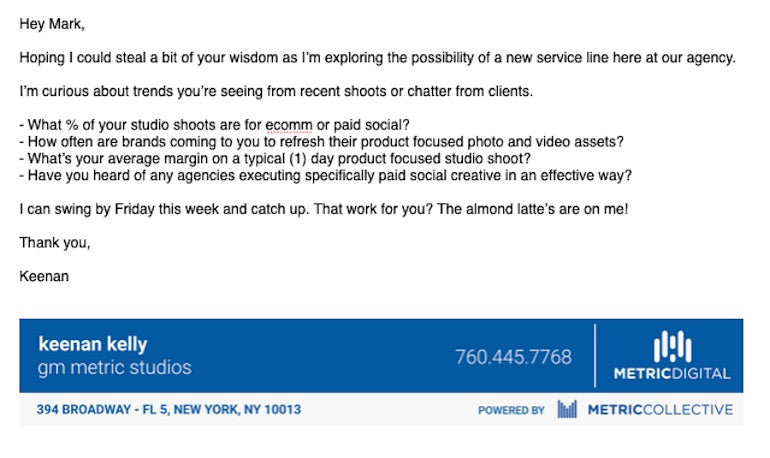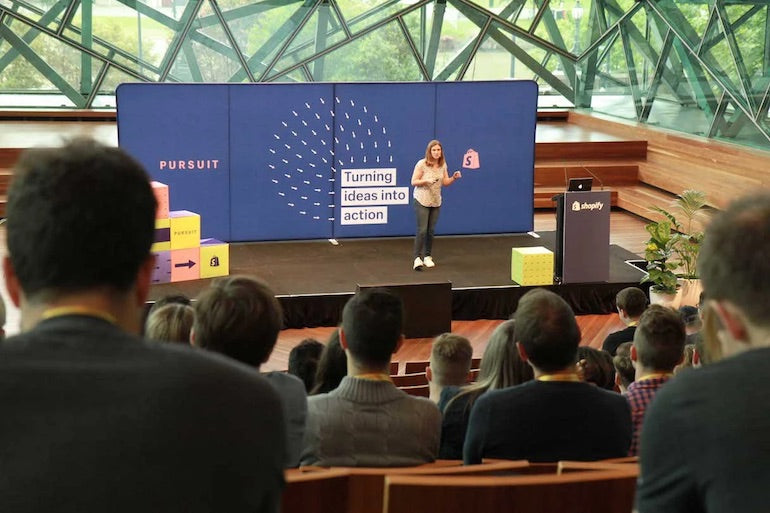
In a previous post on Shopify’s Web Design and Development Blog, How to do a Competitive Analysis That Drives Results for Your Clients, you learned which tools can give you key insights into the channels driving traffic and revenue for other businesses in your client's industry. Essentially, it was an introduction on analyzing your competitive landscape.
Building off those quantitative tools, this post will expand your repertoire of business growth strategies with additional ideas on how to understand and exploit gaps in your current strategy.
In part one of this article, we’ll share tactics to assess your competitive landscape and expand your services, knowledge and power.
In part two of this article, we’ll talk about leveraging the white space uncovered for your new service line, with a case study from our own agency’s experience.
Archimedes famously observed, give me a place to stand on, and I will move the earth. Now it’s time to create that same leverage for your company. No toga necessary.
Ask and your company shall receive
Understanding and creating leverage within your competitive landscape is all about asking smart questions. Here is a list of seven thought starters to ask your leadership team that will get everyone thinking about how to grow your business through the greatest sales tool known to man: your ears.
1. Who are your trusted mirrors?
A helpful first step in receiving candid feedback about your competitive landscape is to poll everyone in your network. We’re not talking about spamming the world here—this is about a targeted outreach plan with trusted colleagues (not clients) who speak your language and who will honestly reflect your value (and your competitors’ value) back to you.
"This is about a targeted outreach plan with trusted colleagues (not clients) who speak your language and who will honestly reflect your value (and your competitors’ value) back to you."
As anyone in professional services knows, the technology of making an effective request is an art and a science. But when you ask, your company shall receive. Here’s a sample of the kind of email I sent out when I first began our company’s research on the competitive landscape. Feel free to adapt this to your business needs:

Once you’ve had these chats a dozen times, form a master list of competitors. Then, cull that down to your top ten. Now you’re ready to dive deep.
You might also like: Building Partnerships: Shopify Partners Share How They're Creating Long-term Value.
2. What world can you borrow from?
If you’re a Shopify app developer, don’t limit your competitive research to that function. Or if you specialize in store template design, make sure you’re educating yourself outside of your department. There’s always something to learn from the world of professional services, even if the final product is different from yours.
My background, before becoming General Manager of Metric Studios, was working in event production and experience design. That’s a very different world than Facebook and Instagram advertising, where my focus is currently. However, what my background afforded me access to was an extensive network of creative directors, photographers, designers, and other creative professionals. This meant that I could chat people up about what my new company was trying to do, and get feedback from them. Their insight was priceless.
You can do the same for your company. Think about your (and your teams’) respective backgrounds. What other industries have you worked in? Who else might illuminate the competitive landscape that works in parallel to you? Sit down and give them your pitch. Ask them:
How would you execute this kind of work at scale? What barriers do you see to our business model? What processes have you honed with your clients? What kind of scones do you prefer with your coffee, and how many can I buy for you?
There will be commonalities you can learn from. These colleagues, despite working in different industries, will help expose your blind spots as a business. They can help you frame up your pricing, core services, potential areas to grow, and develop your point of view on the horizon for what your clients are going to want two to four years from now.
3. What rabbit hole will cover all my competitive bases?
Flood your brain with information. Go deep early. Do homework. Overwhelming yourself in the beginning of the process, inhaling as much competitive content as your intellectual lungs can handle, will pay off somewhere down the road.
Read every page of every competitor’s website. Subscribe to their newsletters. Download their free whitepapers. Notice how you feel when you receive their automated email flows. Sign up, attend, and engage in their webinars. Look at their service design in terms of their unique process. Notice how they position their brand overall, how they talk about their service offerings, what their price points are, and so on.
Attend conferences, local meetups, and other network events within your industry. Meet people from competitors. Watch everything they do. See how they position and talk about themselves. Evaluate their booths, speeches, marketing collateral, and so on.

Then, come back to your office and put all those notes and materials together in one place. Think of yourself as one of those detectives on the police television shows who pins mugshots of serial killers on the office bulletboard. Except this time, the killer is you.
Actually, never mind that last part.
You might also like: Announcing Shopify Pursuit 2020: Turning Ideas Into Action.
4. Which clients could be a source of insight?
Have as many conversations with clients (potential and former) as possible. View this as a gut check against your own level of service. That feedback is priceless and helps you understand what you’re up against, and how to grow in the future.
Check in with clients after they’ve left and moved on. If they chose to take their marketing, design, or development in-house, it’s worth finding out what they like and don’t like about it. As long as you come from a place of curiosity, from the mindset of learning how to improve your own client services, then people will be happy to share their experience.
"As long as you come from a place of curiosity, from the mindset of learning how to improve your own client services, then people will be happy to share their experience."
Don’t be afraid to ask clients who else they hear is best in class at what they do. You can quickly find out who else in the industry has a good reputation, notice the common attributes, and model your services after that.
5. To what degree is this competitive feedback applicable and actionable?
The final caveat for all of these strategies is, be careful how you weigh information. Feedback is source-dependent, and you don’t want to universalize a particular. For example, if only one or two clients out of your total book of business are asking for 3D modeling services, and you don’t have the expertise, resources, or desire to expand into that service line, then don’t do it. Otherwise, you’ll position yourself as yet another “buffet agency,” as we like to joke, meaning a company that does a little bit of everything, but actually excels at nothing.
"Feedback is source-dependent, and you don’t want to universalize a particular."
On the other hand, if your Net Promoter Score has been steadily declining over the past six months, and the commonality from all of your conversations with churning clients is that they’re all asking for ongoing website management in addition to design, take that as a hint. You might be able to increase your average revenue per client by hiring one or two new team members with that expertise.
With these five questions, you’ll be well on your way to assessing your competitive landscape so you can expand your services, knowledge and power.
You might also like: How to Get More App Downloads in the Shopify App Store.
How we grew by leveraging our competitive landscape

In part one of this article, we shared five questions to help assess your competitive landscape to expand your services, knowledge and power.
Next, we want to share a case study on how our agency learned a powerful and profitable lesson on understanding the competitive landscape. Think of it as a behind-the-scenes look, since radical transparency is kind of our company’s thing.
Through this real life situation, you’ll learn how to leverage the white space uncovered for your business. We’ll also reflect on the journey with additional insights and questions.
Identifying the gap
Our performance marketing firm, Metric Digital, has been around for about six years now. Every time we conduct our strategic planning sessions, we think about the ways we create value for clients. Our north star has always been providing services to make the biggest impact to overall performance of a company’s marketing, and that may involve managed services, consulting, strategy, educational materials, and even tech solutions.
Initially, our agency started offering paid media and email marketing services, the integration of which makes everything in a brand’s overall marketing machine more profitable. More recently, however, we noticed a whitespace within our competitive landscape that presented us (and our clients!) an exciting growth opportunity.
Here’s the context. Digital ads on Facebook and Instagram have been getting more competitive than ever before. With 7,000,000 companies advertising (up from 6,000,000 last year), we knew a few things:
- Facebook gives preferential treatment to brands who have better ad creative. Users are far more likely to engage, like, share, comment and repost ads that use performance creative.
- It was critical that every piece of our clients’ Facebook strategy and execution needed to be stronger than ever before. The barriers to creating winning video ads were much higher than running the old image-centric ads, and the bottleneck was undeniable.
- Every day a brand doesn’t have fast, high quality video assets on their core channels, they’re losing potential customers. But if they commit to ongoing creative production, they can consistently create new assets and iterate to drive the performance.
- Very few performance marketing agencies in our space focus on producing ad creative with those kinds of results, which meant there was a gap for our clients that we could satisfy uniquely, effectively, and profitably.
What would your company do in this scenario? How would you leverage that whitespace to grow your business?
Here’s what we did.
Our agency made the decision to open a brand new service line: delivering the production of direct response creative to our clients.
We hired a general manager to build out an in-house team of designers to work with our media buying and strategy teams to build video ads for Facebook, Instagram, Google display, and YouTube. They focused on creating assets that increase conversion rates and help clients scale their spend profitably.
You might also like: How to do a Competitive Analysis That Drives Results for Your Clients.
Learn, learn, as fast as you can
Now that you’ve seen competitive landscape leverage in action, here are four final ideas to help your business pull levers in the future.
1. Find the facets of your service that are unexpected
As your company builds out new service lines, or grows current ones, the element of surprise cannot be overstated. There is no brand vision without it. It’s not enough to differentiate from your competition, you also have to bring unexpected value that your clients haven’t seen before or have only dreamed about seeing.
"It’s not enough to differentiate from your competition, you also have to bring unexpected value that your clients haven’t seen before or have only dreamed about seeing."
In some cases, that unexpected source of leverage could come from speed.
Our agency noticed that most other creative agencies tend to be built through organic social or traditional branded content used in ad campaigns, print, website, and so on. But to stand out, we wanted to build creative services in synergy with and complimentary to the paid social landscape. What we were trying to build was a different creative offering, a different execution.
As such, we took nods from the traditional world, then put it through our lens of executing at scale with speed. We developed a creative briefing, approval, and cadence process that only took a week, which gave us more agility to test and iterate.
2. Use your relationship with data to create leverage
In the world of direct response creative, the ability of a brand to deploy fresh creative and react to data about it in real time is a powerful weapon. Speed has to do with your ability to access data. If you don’t have information on hand and readily available, it can be difficult to decide what creative you need next and why.
"Whatever service your company offers, think very carefully about your feedback loop as it relates to data."
Even if you’re not providing advertising services to your ecommerce clients, this principle applies to everything from design to web development to other technical integrations. Whatever service your company offers, think very carefully about your feedback loop as it relates to data. What friction points could you eliminate? What software platforms would make reporting faster and more streamlined? For example, if your team is still pulling data manually for each client each week, using haphazardly made spreadsheets, you could be hurting your leverage. But if you can narrow that data loop with clients, it will only allow you stand out from the competition better.
Unfortunately, building out any kind of creative work can be a lengthy process. Depending on the number of team members on both the brand and agency side, the rounds of revisions can feel endless. The goal is to use data to position your offering from a speed standpoint.
You might also like: How to Bring Disruptive Thinking to Your Agency’s Clients.
3. Listen louder than your competition
Most of our clients are DTC retail brands, and here’s the most consistent question they ask us: how do our media/strategy teams work together with creative teams to make sure any ads we build are rooted in data/performance?
"By making sure the brand’s left and right brain are represented, everyone has their fingerprint on the solution."
Turns out, not all brands are used to using data to inform design, or building ad creative to inform actionable assets that drive results. This is a good thing. Based on feedback from our clients, our approach to performance marketing ushers them into a very different world that they enjoy. Why? Because it makes them feel heard. Because normally, when brands build creative with an agency or vendor, it’s solely about aesthetic and narrative, and less rooted in performance perspective. Both are important, but by making sure the brand’s left and right brain are represented, everyone has their fingerprint on the solution.
Recently, one of our beauty clients recently told us how refreshing it was to work with a team that truly comes to the table with data to back their creative ideas. They said how 99 percent of the agencies out there don't do this, and they really appreciated having the support of media and creative departments together.
What departments, stakeholders, individuals, or teams within your clients’ businesses are not currently feeling heard? Whose opinions are marginalized or ignored, and would love to have a stronger voice? Grow bigger ears and start listening louder than your competition, and soon the only sound you’ll hear is the cash register.
4. Anticipate client demand to put your agency in their future

Clients will likely have unmet needs that they want you to help them with. They might even ask you: hey, do you have anybody to recommend this service? Pay very close attention when clients make the same request over and over. If you’re a website design agency who specializes in Shopify and Wordpress, and 50 percent of your clients are asking for a vendor that knows Craft CMS, that should tell you something. Perhaps that’s the whitespace you’ve been waiting for.
Notice the services that clients say they’re not getting well executed, fast enough, or with the right attitude. Every complaint is a gift, and if you accrue enough empirical data, you can decide based on what you know that clients need something, and aren't being serviced well on currently.
Also, during pitches, discovery calls and other initiate conversations with clients, note the patterns in questions. What two or three things, that everybody seems to be asking about, do you not currently offer? What if you did? If prospective clients are telling you that they really want a vendor who can design affiliate marketing programs, that’s a sign. If current clients are churning and leaving your agency to go somewhere else for a particular service that you weren’t offering, this might be a retention opportunity to nip that loss in the bud and beef up your service line.
Listen to your competition to grow your agency
Ultimately, there is no business landscape that isn’t competitive. But that’s a good thing. If it wasn’t competitive, you wouldn’t be in the right business.
With these leverage questions and insights, you’ll be on your way to exploiting gaps in your current strategy and moving the earth!
Or if not the earth, at least your clients’ profits.
Read more
- Working On-Retainer: Why the Survival of Your Development Business Rests on Long-Term Clients
- How to Collect the Right Information from Your Clients
- How Accessing the Partner Ecosystem Can Help You Grow Your Business
- 4 Conferences You Should Attend
- Introducing the Next Shopify Partner Accelerator
- Email Marketing Best Practices for 2020
- 7 Ways to Create an Amazing Customer Experience for Your Clients’ Ecommerce Stores
- Learning How to Code, the Long Way Around
- What Keeps All the Devs in Your Yard? How to Retain Technical Talent for Your Agency
- 4 Key Ways to Differentiate Your Clients’ Ecommerce Stores From the Competition
How has the competitive landscape helped your business grow? Share your insights below.

